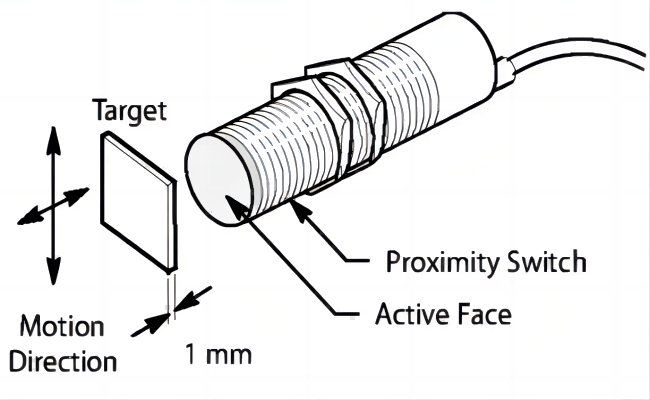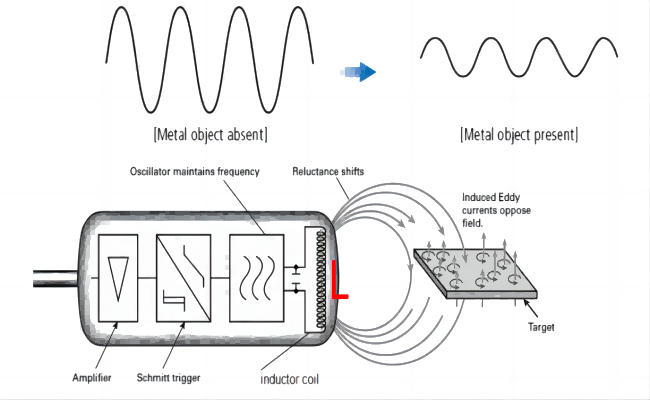What is a Proximity Sensor?

What is an Inductive Proximity Sensor?
How Do Inductive Proximity Sensors Work?

An inductive proximity sensor is fundamentally comprised of an inductor coil, often referred to as a coil. When an electric current is conducted through this coil, it generates an electromagnetic field in the surrounding area.
The operation of the sensor begins with an oscillator that generates an electromagnetic field around the inductor coil. This field remains consistent in the absence of a metallic object, as evidenced by the stable wave depicted on the left side of the image ([Metal object absent]).
When a metallic object, referred to as the “Target” in the accompanying image, approaches the active face of the sensor, the electromagnetic field induces eddy currents within the object. These induced eddy currents subsequently generate opposing electromagnetic fields, as illustrated in the image. This opposition results in a modification of the overall electromagnetic field enveloping the coil.
The introduction of the metallic object induces a shift in reluctance, which in turn influences the oscillating frequency and amplitude of the electromagnetic field.
The altered wave on the right side of the image ([Metal object present]) visually represents this transformation in the electromagnetic field resulting from the interaction with the metallic object.
Detection Circuitry
-
Amplifier: It amplifies the signal received from the oscillator.
-
Schmitt trigger: This is a type of comparator circuit that translates the received signal into a clear on/off output. When the signal varies due to the presence of a metal object, the Schmitt trigger outputs a clear digital signal, indicating the detection of the object.
What are the Components of Inductive Proximity Sensor?
-
Oscillator Stage: Generates an electromagnetic field using a coil.
-
Demodulator Stage: Rectifies and refines the signal from the oscillator for subsequent processing.
-
Trigger Stage: Utilizing mechanisms like the Schmitt trigger, it establishes when a metallic object is nearby based on the signal’s threshold.
-
Output Stage: Conveys the detection occurrence to external devices, typically via a transistor.
Advantages of Inductive Proximity Sensors
-
Inductive Sensing: Facilitates the detection of metallic items without physical contact, vital for various industrial applications.
-
Superior Longevity: The absence of moving components and touch-free operation ensures prolonged durability and reliability.
-
Operational Stability: These sensors maintain consistent performance amidst environmental factors such as dust, humidity, and vibrations, guaranteeing reliability in rigorous environments.
Applications of Inductive Proximity Sensors
-
Position Sensing: These devices are implemented to ascertain the location of moving components within machinery, thereby guaranteeing accurate control and operation.
-
Speed Monitoring: These are engaged in non-contact wheel speed sensing to oversee and regulate the velocity of motors and conveyors.
-
Metal Detection: This technology is applied in packaging and quality control processes to identify metallic contaminants or verify the inclusion of metal components.
What is a Capacitive Proximity Sensor?
How Do Capacitive Proximity Sensors Work?

A capacitive proximity sensor operates on the fundamental concept of capacitive coupling. Within the sensor is an intrinsic capacitor plate; when an object nears the sensor, it effectively functions as a secondary capacitor plate.
The sensor incorporates an oscillator circuit that, together with the intrinsic capacitor plate, establishes a resonant circuit. This oscillator emits an electric field emanating from the internal capacitor plate. As an object, referred to as the “target,” comes closer to the sensor, it performs the role of an auxiliary, or “effective,” capacitor plate.
The intervening non-conductive medium, such as air, between the sensor and target serves as the dielectric. The target material’s dielectric constant dictates the alteration in capacitance, influencing the sensor’s detection capability. The capacitance amplifies as the target approaches the sensor due to the diminished dielectric distance between the plates. In contrast, the capacitance diminishes as the target recedes. This capacitance fluctuation influences the oscillator circuit’s resonant frequency.
An integrated current sensor perceives the current variations within the oscillator circuit, which result from these capacitance alterations. Should this change surpass a predetermined threshold, it signifies the target object’s presence or absence. The sensor operates on a DC power source, and upon discerning capacitance variations, it provides a DC output signal that indicates the target object’s proximity.
What are the Components of Capacitive Proximity Sensor?
-
Oscillator Circuit: This circuit is responsible for producing an oscillating electric field.
-
Threshold Detector: It monitors any changes in the oscillation amplitude resulting from the nearby presence of an object.
-
Output Circuit: Upon detecting a signal, this circuit processes the information and delivers an output, signifying whether the object is present or absent.
Advantages of Capacitive Proximity Sensors
-
Broad Material Detection: Suitable for identifying both metallic and non-metallic entities, ensuring adaptability across varied applications.
-
Enhanced Sensing: Efficient in detecting substances even through non-conductive barriers, including the ability to sense liquids and granulated materials.
-
Tunable Sensitivity: Many models feature customizable sensitivity settings to meet diverse detection needs.
Applications of Capacitive Proximity Sensors
-
Liquid Level Monitoring: They are used to monitor the level of liquids in containers or pipelines.
-
Material Verification: Employed in packaging industries to verify the presence of materials within containers.
-
Thickness Measurement: Utilized to measure the thickness of materials by detecting the proximity of the material surface.
Capacitive vs Inductive: Which is the Best Choice?
|
Aspect
|
Capacitive Proximity Sensor
|
Inductive Proximity Sensor
|
|
Detection Material
|
Both metallic and non-metallic objects
|
Predominantly metallic objects
|
|
Working Principle
|
Measures changes in capacitance
|
Relies on electromagnetic induction
|
|
Sensitivity
|
High; can detect liquids and non-metallic materials
|
Primarily sensitive to metal objects
|
|
Sensing Range
|
Varies; can be larger in some cases
|
Typically 1mm to 60mm
|
|
Environmental Robustness
|
Moderate
|
High resistance to dust, humidity, and vibrations
|
|
Interference
|
Can be affected by high humidity or presence of other materials
|
Less affected by environmental factors; can be influenced by nearby metals
|
|
Cost
|
Generally higher
|
Often lower
|
|
Applications
|
Liquid level monitoring, material verification, thickness measurement
|
Position sensing, speed monitoring, metal detection
|
|
Power Consumption
|
Varies; typically low
|
Usually low
|
|
Configuration
|
Adjustable sensitivity
|
Fixed sensitivity
|
|
Durability
|
Can be affected by extreme environmental factors
|
Highly durable due to non-contact detection
|
FAQs
What are the common troubleshooting steps for these sensors?
- Wiring Integrity Assessment: Conduct a thorough examination of the wiring connections to identify any discrepancies or potential issues.
- Sensor Surface Examination: Ensure that the sensor’s surface remains pristine and free from any obstructions or contaminants.
- Configuration Validation: Verify that the sensor’s operational parameters are appropriately configured.
- Power Supply Evaluation: Confirm that the sensor consistently receives a sufficient and stable power source.